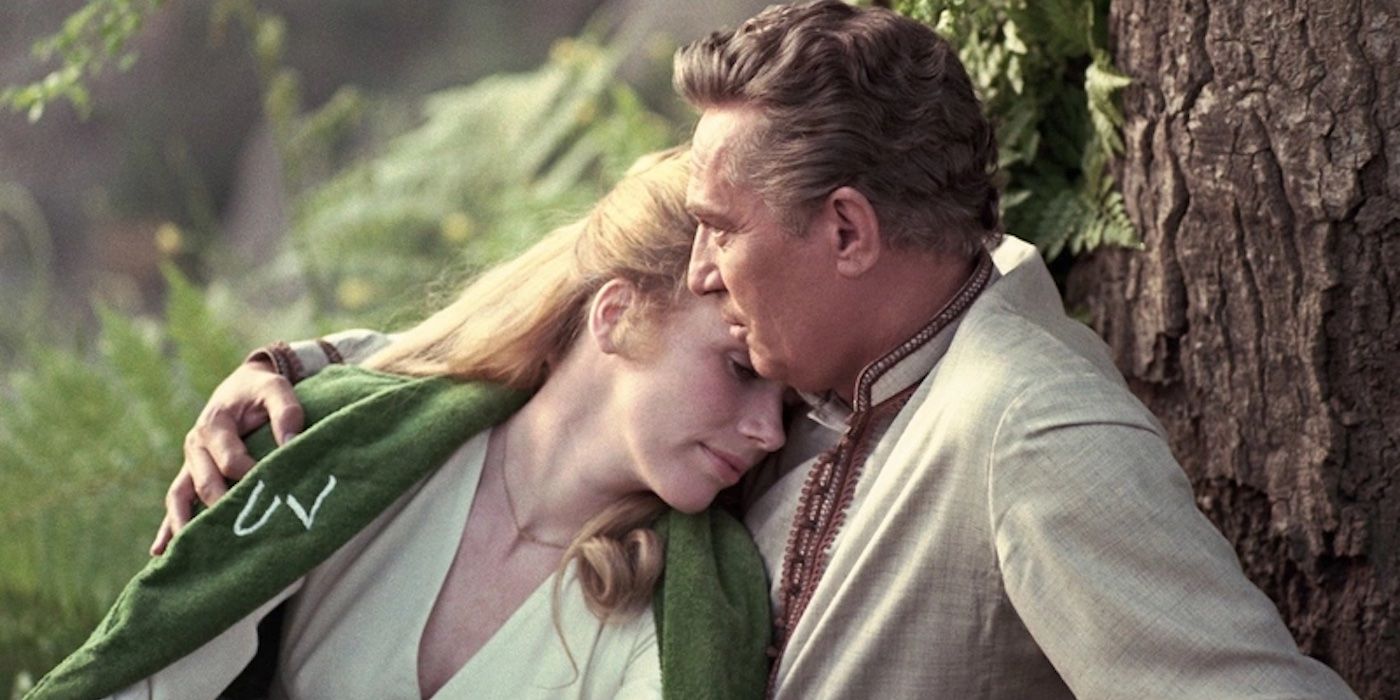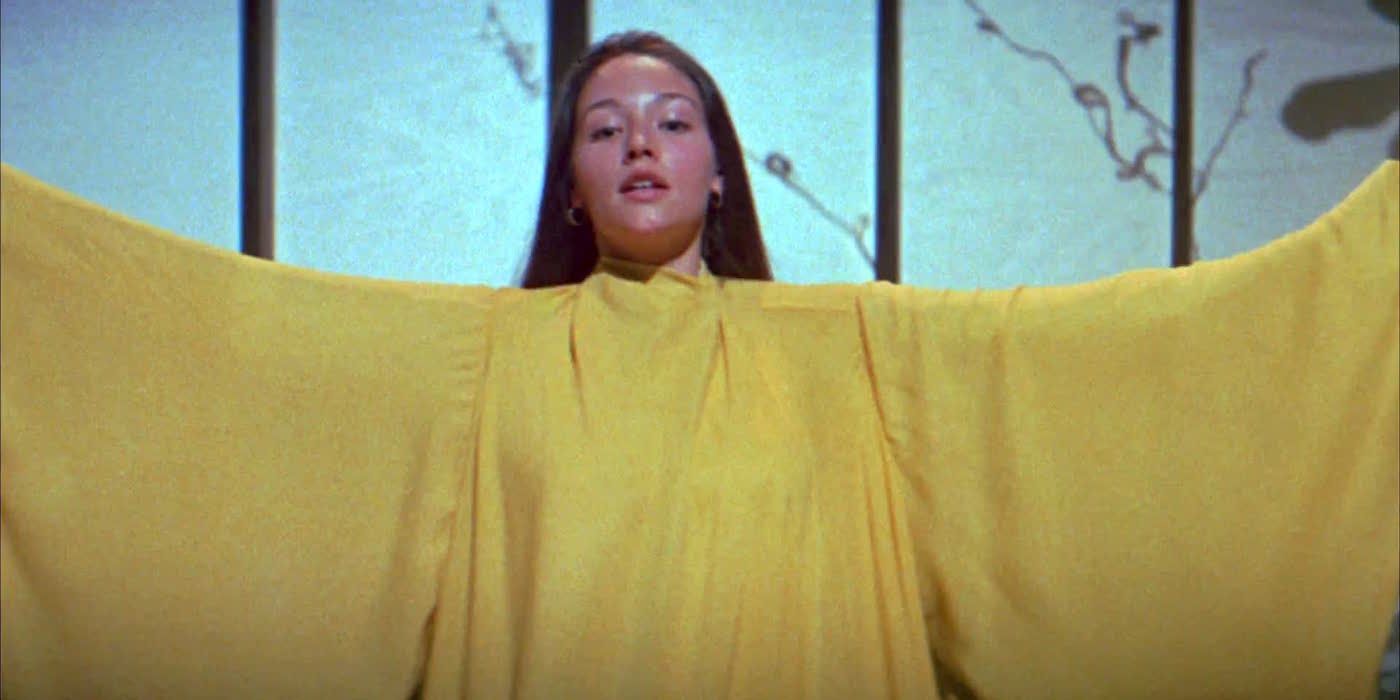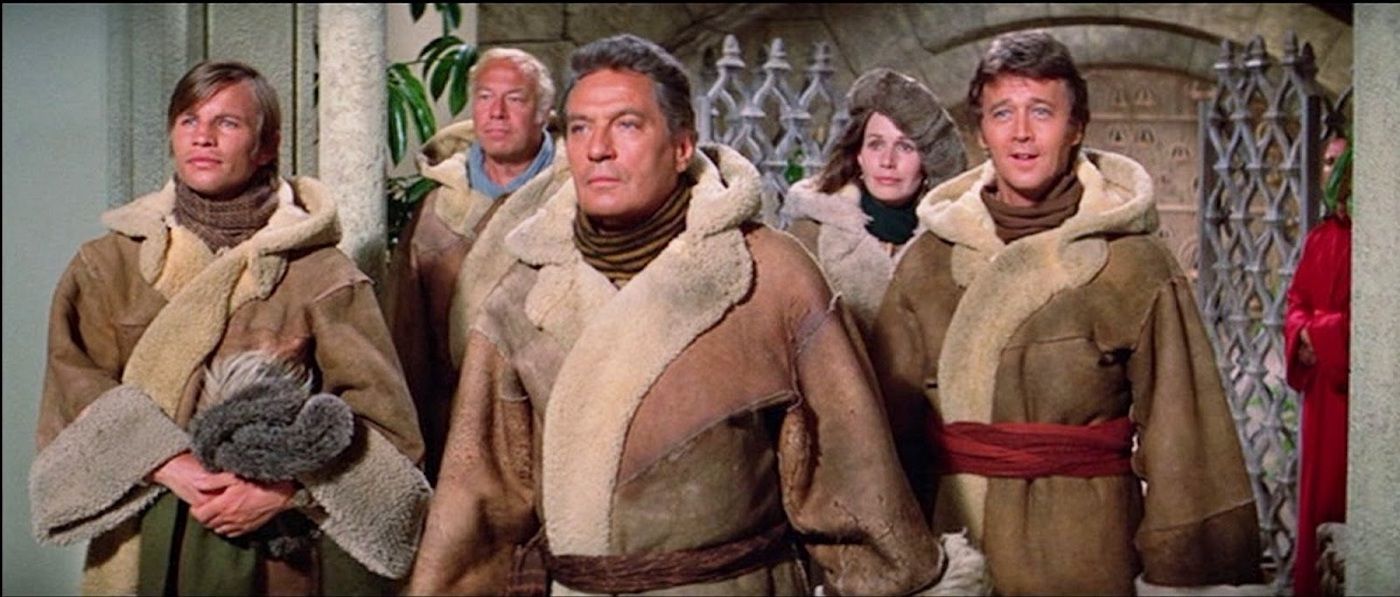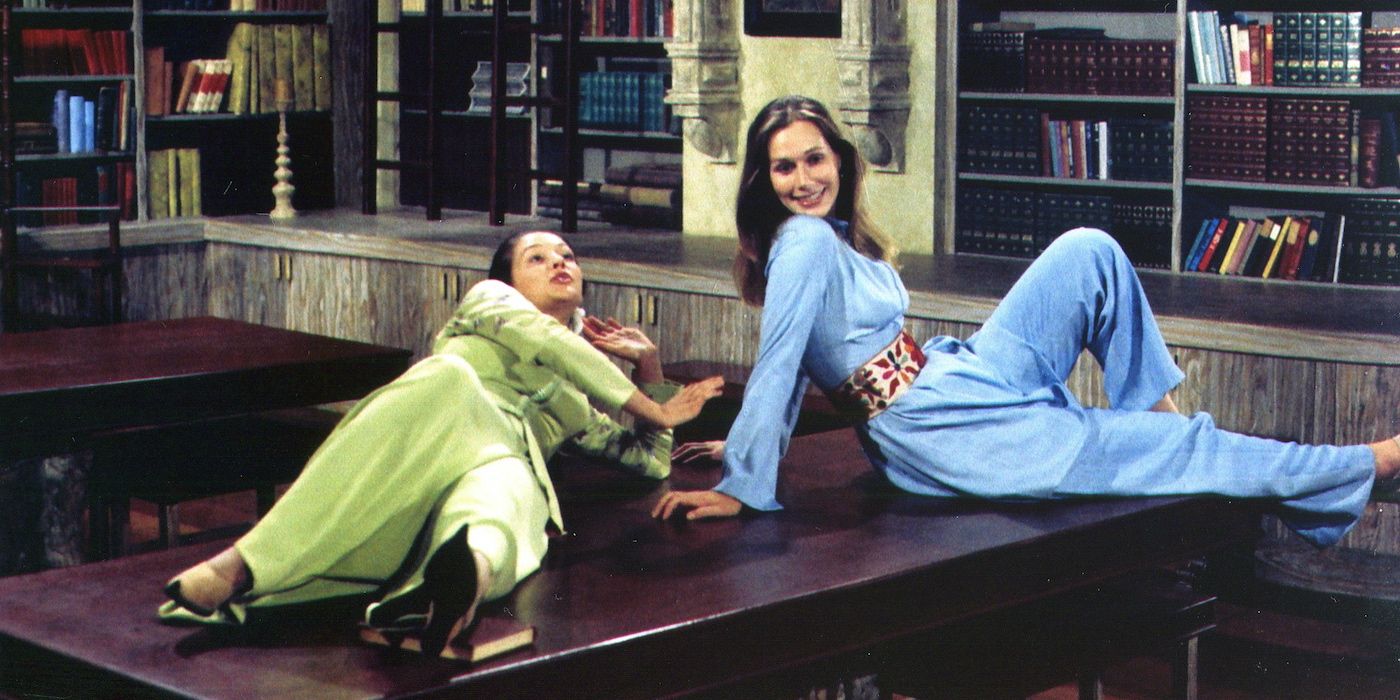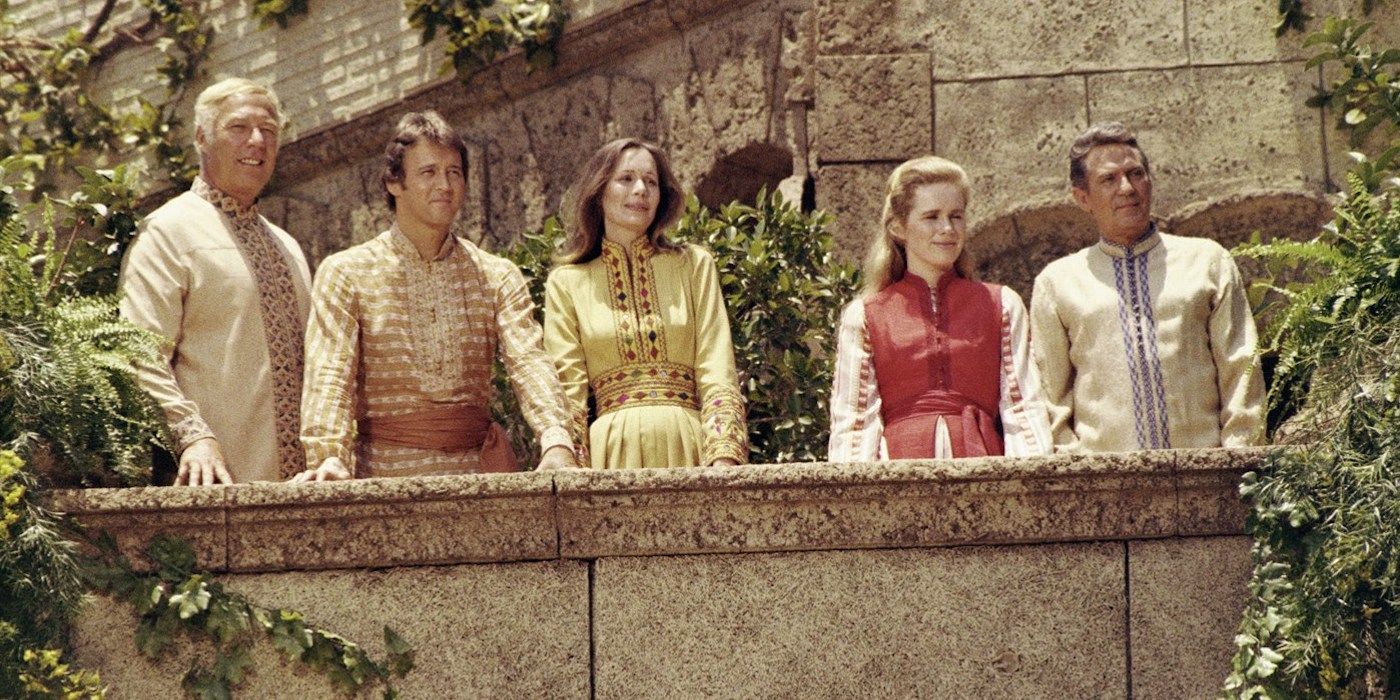"Can there be joy where there has been no sorrow?" Oscar winner Peter Finch belts out these thought-provoking song lyrics in the musical adaptation of the James Hilton novel, Lost Horizon, and it's probably safe to say there was very little joy and lots of sorrow on the set of this ill-fated film. In 1973, producer Ross Hunter had the grand idea to turn the classic story of Shangri-La, first brought to the screen by director Frank Capra in 1937, into a big-budget singing and dancing extravaganza with an all-star cast. Hunter was successful at this kind of thing. He produced the lavish 1953 remake of Magnificent Obsession that turned Rock Hudson into a star. He also helmed the sumptuous 1959 re-imagining of Imitation of Life, breathing new life into Lana Turner's career and setting up young Sandra Dee for future movie success. It was practically a no-brainer that Hunter would make lightning strike again by rebooting Lost Horizon, so Columbia Pictures opened its big checkbook and said to Hunter, "Let's do it!" Lightning struck, all right, setting pretty much everything on fire and leaving nothing but smoldering ruins. What happened? How could a visionary like Hunter go so wrong that Lost Horizon would end up in The Official Razzie Movie Guide as one of the "100 Most Enjoyably Bad Movies Ever Made?"
Audiences Value the Truth
In Hollywood, timing is everything. The "golden age" of the movie musical, from the 1930s through the 1950s, gave audiences a chance to escape from reality and immerse themselves into a world of pure fantasy and fun. In the 1930s, it was the Great Depression everyone wanted to forget about. In the 1940s, it was World War II, and in the 1950s, it was the threat of nuclear annihilation. Seeing stars suddenly burst into song and tap dance across the floor was exactly what moviegoers wanted and needed - a chance to enter into the land of make-believe, where the biggest conflicts usually revolved around whether the old barn would be ready in time for the big show or whether the ingénue from Topeka would make it big on Broadway and find Mr. Right. By the time the 1970s rolled around, everything had changed. The nation was still immersed in the Vietnam conflict, with news programs broadcasting the violence and carnage nightly and in living color to living rooms all over America. The United States was in a period of cynicism and mistrust, and movies were reflecting that. 1970's M*A*S*H was a gritty look at the insanity of the Korean War, 1971s A Clockwork Orange presented a frightening, brutal dystopian future, and 1972's The Godfather exposed the cruel power of the organized crime world.
Recreating Former Glory
In 1973, the idea of an old-fashioned musical about a mythical kingdom where everything is beautiful, sadness doesn't exist, and everyone stays young should have been seen as a big gamble, even with someone as successful as Hunter behind the wheel. Hunter may have believed (and maybe the suits at Columbia, too) that an old-school feel-good movie was exactly what America needed during such a turbulent time. But Hunter probably didn't fully understand that audiences were maturing. Realism was the name of the game now. People plunking down $1.75 for a movie ticket wanted to see their world reflected, not washed away in a sea of frivolity. To be fair, Lost Horizon does begin with a bang - literally. The movie's opening scene shows a series of explosions, with guerillas bombing an airport in an Asian city as residents and visitors desperately flee. The film's theme song, a very folkish tune sung by folkish-sounding Shawn Phillips even contains the lyrics, "There's a lost horizon waiting to be found...where the sound of guns doesn't pound in your ears anymore." It may have been Hunter's and director Charles Jarrott's intention to ground the film in some sense of the reality around the Vietnam era. Aside from the movie's chaotic beginning, however, any further semblance to real life is non-existent.
The Soundtrack
On the subject of music, the film's soundtrack certainly didn't help the doomed production. Producer Hunter recruited the powerhouse duo of Burt Bacharach and Hal David to write the movie's songs. Just three years earlier, the pair had won an Oscar for composing "Raindrops Keep Fallin' on My Head," from 1969's Butch Cassidy and the Sundance Kid. The two were proven successes, with dozens of hit songs to their credit, like "Close to You," "Walk on By," and "Do you Know the Way to San Jose?" Their musical style, however, didn't jibe with the movie's spirit. Shangri-La is a far Eastern paradise hidden away in the Himalayas. The film needed a soundtrack that captured the essence of a serene dreamland - something meditative, tranquil, and ethereal. Bacharach and David were known for lighthearted, catchy pop songs that people sang along to in their cars on the way to work.
The film's "Festival of the Family" sequence is an extravagant tableau that begins with dozens of extras dressed like Buddhist monks, chanting, marching in unison, and dangling incense urns as they carry a young couple and their newborn child on an elevated platform. It's a spectacularly beautiful and calming scene. Suddenly, the "oompa-oompa" music begins, the tempo picks up, and the viewer is transported out of paradise and into the land of AM radio with "Living Together, Growing Together," a silly pop tune with even sillier lyrics like, "Start with a man, and you have one. Add on a woman, and then you have two." The juxtaposition of an ancient Eastern ritual with easy-listening music was more than a bit jarring. This is the case with most of the film's musical numbers; creating an unintended sense of camp around the entire movie.
Even Bacharach himself wasn't pleased with the music, and, as he wrote in his 2012 autobiography, Anyone Who Had a Heart: My Life and Music (pp. 154 and 156), his outspoken displeasure with the soundtrack effectively ended his long-term partnership with Hal David (not to mention getting Bacharach booted from the movie's post-production editing suite). Surprisingly, the Lost Horizon soundtrack did manage to hit the Billboard album charts, landing in 53rd place, and artists like Diana Ross, Marvin Gaye, and The Fifth Dimension recorded cover versions of some of the movie's songs on their own albums. Listened to as stand-alone singles, the movie's music is pleasant enough. It just didn't work within the film's context.
Can Anyone Here Sing or Dance?
The casting was another problem that contributed to Lost Horizon's failure. Generally, when assembling stars for a musical, performers who can sing and dance are at the top of the list. This musical's cast, however, included Peter Finch, Liv Ullmann, Michael York, George Kennedy, Sally Kellerman, Olivia Hussey, and Sir John Gielgud, for heaven's sake. It's not necessarily unusual for non-singing stars to get the leads in movie musicals and have their singing voices dubbed in by others. Natalie Wood in West Side Story is one example, as is Audrey Hepburn in My Fair Lady. These actresses were cast based on their acting as well as their abilities to bring audiences into theaters and create box office receipts. Not to disparage any of Lost Horizon's cast members, all of whom were fine actors with long lists of award-winning credits, but in 1973, was anyone really champing at the bit to see Sally Kellerman flit about paradise with George Kennedy? Were folks really clamoring to see Peter Finch and Liv Ullmann do the two-step? Although most of the film's cast members didn't do their own singing, choreography was a bigger challenge.
Hermes Pan, who created so many classic Fred Astaire-Ginger Rogers numbers, had his work cut out for him on this production. Most of the dancing in the movie is little more than stylized walking with a hand flourish thrown in here and there. To this day, there's something so entertainingly awkward about watching Liv Ullmann, queen of the Ingmar Bergman dramatic film oeuvre, frolicking through the greenery with Shangri-La's school children, wildly swinging her arms to and fro while mouthing the words to "The World is a Circle." Sally Kellerman and Olivia Hussey don't fare much better as they roll around on tables and climb ladders in the Shangri-La library while performing "The Things I Will Not Miss." Only one cast member, Bobby Van, was an actual movie musical veteran - a terrific performer who could act, dance up a storm, and carry a tune. Not surprisingly, he's really the only person in the movie who comes away relatively unscathed. His "Question Me an Answer" dance number is old Hollywood all the way, and one of the few genuinely bright spots in the film that bears choreographer Pan's trademark style.
Production Woes
Although the $6 million budget for Lost Horizon wasn't considered astronomical, even in 1973, a big portion of the film's production costs went to the construction of the Shangri-La kingdom on the studio's back lot, leaving less money for other essential items like interior sets and costuming. Most of the indoor scenes look like they're filmed in badly decorated Chinese restaurants with gaudy porcelain peacocks and hanging tapestries from Pier One Imports. Famed designer Jean Louis, who created the iconic dress Marilyn Monroe wore to John F. Kennedy's birthday celebration, put together the film's wardrobe, which, for the men, was essentially modified Nehru jackets, and for the women, bell-bottom pantsuits with fancy silk sashes as belts. Perhaps due to budget constraints, Louis was limited in his creative abilities. Like the movie's soundtrack, though, the costuming doesn't quite capture the essence of the film's utopian setting.
The Script
Then there's the script. It's hard to imagine how Larry Kramer, novelist, playwright, renowned gay rights activist, and Oscar-winning writer of 1969's Women in Love, got involved in this ill-fated production. Credited with penning the film's script, it's even harder to imagine a writer with Kramer's talent not being able to elevate the screenplay to a higher standard. With lines like, "Your lives are, as a rule, shorter, not so much by natural death as by indirect suicide," and "Your life is made up of infinite possibilities, and you're not realizing one of them," the film comes across as a self-help audiobook that failed to sell well. In a 2007 interview with the SF Weekly publication, Kramer confided that the "the only thing I’m truly ashamed of is how I was talked into writing the musical version of Frank Capra’s Lost Horizon." It seems like even Kramer knew he had reluctantly boarded a sinking ship when he agreed to adapt Hilton's novel for the screen.
A Hollywood Flop to Remember
Despite the trouble-plagued production, Columbia strongly promoted Lost Horizon, giving it star-studded premiere events in New York and London, with Queen Elizabeth herself attending the latter. Clothing, jewelry, fragrances, and furniture "inspired" by the film were sold in department stores. Even with the aggressive promotional efforts, the film bombed at the box office and was ravaged by critics. According to the Village Voice , Bette Midler even joked, "I never miss a Liv Ullmann musical." Seemingly doomed from the outset, Lost Horizon is still remembered nearly half a century later as one of Hollywood's biggest missteps. It was the wrong movie produced at the wrong time, with the wrong music, wrong cast, and wrong script. But with everything that's wrong about it, it's still the right movie to enjoy as a guilty pleasure today.

